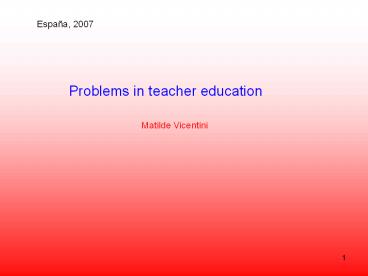Diapositiva 1 PowerPoint PPT Presentation
1 / 15
Title: Diapositiva 1
1
España, 2007
Problems in teacher education
Matilde Vicentini
2
- Teaching and learning models
- Suggestions from PER research on how to teach
- What Physics for teachers ?
3
The Teacher
A person who is in charge of theeducation of the
young generationfor what concerns general skills
and the understanding/learning of the
subject(s) of his/her competence
4
A model for teaching
Teaching the communication of
informations with the aim that
students will understand / learn
The teacher defines the
Aims of the communication
and choices
the information contexts
the argumentsand their organization
verbalcommunication
recall of real life situation
experiments
Coding of the message
Didactical action
5
The students
Collect the informationsthat are meaningful to
their knowledge schemes
choose the information context
reference to already known
personalmemories
Decoding of the message
Interpretation
Possibility of a gap of understanding
6
Possibility of a gap of understanding
need to define the set of shared meanings
The students informationcontext
The teacher informationcontext
Subjectivemeaningsof theteacher
Subjectivemeaningsof thestudents
Sharedmeanings
need to refer to a learning model
7
A learning model
Learning
acquisition of knowledge
guided by motivation
experience
received through
communication
in the long termmemory
declarative procedural
needed to understand
Different styles of Intelligence
that use
thinking skills
innate
learned
intuitive
formal
descriptive
8
about intelligence
Sports Winning coaches, for example, recognize
the different learning styles of their players.
Former Raiders coach John Madden says that for
some players you simply tell them the play and
they know it others must be shown diagrams
before they can form their own mental image of
what to do and still others wont really grasp
the play until they physically run through it so
that they can feel the play as well as see and
hear it. The same is true for the coaches of
military recruits and corporate training
programs. Neil A. Fiore, The Now Habit (Jeremy
P. Tarcher, Inc., Los Angeles, 1989), p. 180
9
about intelligence
Physics There are, as I have said, some minds
which can go on contemplating with satisfaction
pure quantities presented to the eye by symbols,
and to the mind in a form which none but
mathematicians can conceive. There are others who
feel more enjoyment in following geometrical
forms, which they draw on paper, or build up in
the empty space before them. Others, again, are
not content unless they can project their whole
physical energies into the scene which they
conjure up. For the sake of persons of these
different types, scientific truth should be
presented in different forms, and should be
regarded as equally scientific, whether it
appears in the robust form and the vivid coloring
of a physical illustration, or in the tenuity and
paleness of a symbolic expression. James Clerk
Maxwell, 1870.
10
The teacher should
- be able to motivate the students
- devise methodological strategies for a
successful communication - understand that communication must be in the two
directions of talking and listening - be competent on his/her subject
- understand the structure of the subject matter
- be able to transform it into forms that are
pedagogically powerful - act as a bridge between the subject matter and
the students - be able to set the boundaries between different
kinds of knowledge and beliefs shared / used in
the society
How to teach ?
What Physics for a teacher ?
11
How to teach
- take into account the ideas that students have
about the phenomena of daily life - importance of interactivity with the students
and among the students
- show experiments and problematic labwork or
projects - exploit the information technology
- group work and peer discussion
- historical considerations
- explicit the relation phenomena-models-theories
- reflect on their own understanding of the subject
- stimulate the rephrasing of students of laws,
principles,
12
What Physics for teachers
The seven savoirs for an education for the
future (MORIN)
- the human condition
- the terrestrial identity
- understanding
- the ethics of humans
- The character of human knowledge with the risk
of errors and illusions - The principles of pertinent knowledge
- Coping with uncertainty
13
Pertinent knowledge
- The ability to place in the global and basic
problems of today the partial and local
knowledges - Avoid the fragmentation intradisciplinary and
interdisciplinary - Place the information in a context and show the
relations and influences between the parts and
the whole
Uncertainties
We should learn to live in an ocean of
uncertitude through islands of certitudes
14
Suggestions for avoiding the fragmentation
- Reference to a discrete particle model
- Consideration of advanced technologies
- Communication of the epistemological context
- Consideration of the social context
15
Conclusions
Need of improving the communication in the two
directions between Physics Researchers and PER
Researchers
Authentic Science
Inquiry
Simulation
Modelling

